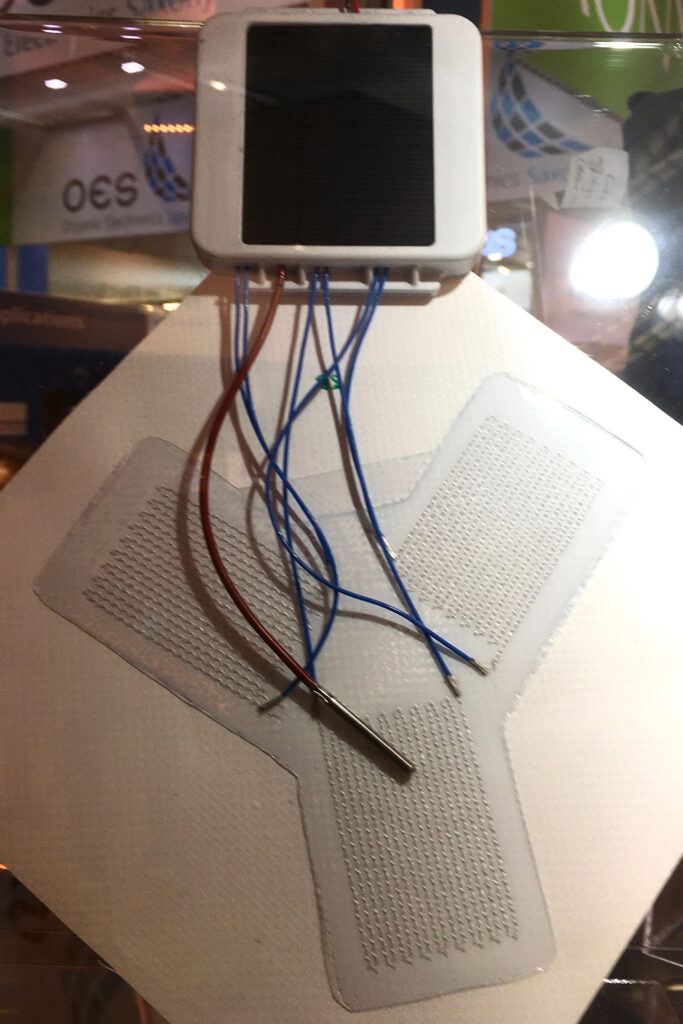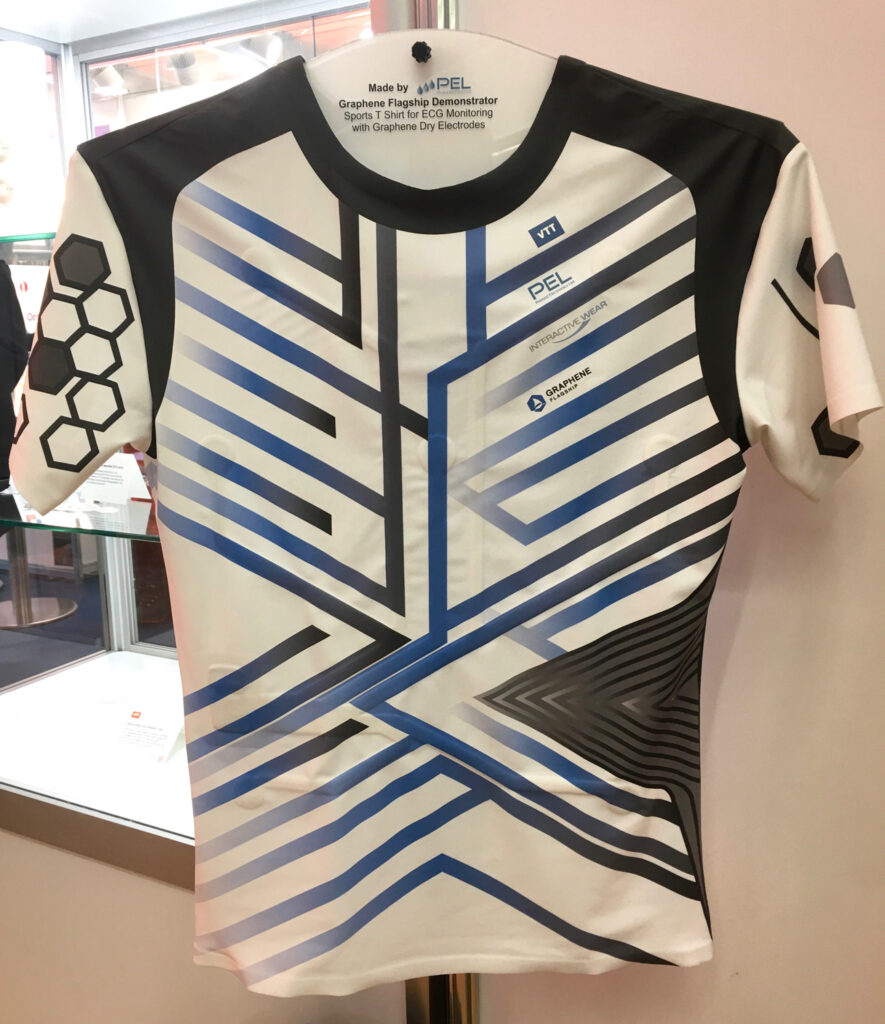
Can printed electronics (PE) and flexible hybrid electronics (FHE) offer e-textiles direction that overcomes the design, manufacturing and sustainability challenges facing the industry? The annual conference and trade show LOPEC (Large-area, Organic & Printed Electronics Convention) was recently held in Munich with 176 exhibiting companies from 28 countries and more than 2,400 visitors from 48 countries. The biggest take-away from presentations and conversations with exhibitors was just how interlinked those three topics—PE, FHE and e-textiles—are, so that in finding solutions for one, progress is also being made in the others. From an e-textile point of view, it is also clear that the fiber and textile industry needs to have a greater presence to overcome PE stakeholder preconceptions.
Cooperation required
Dr Klaus Hecker is the managing director of the Organic and Printed Electronics Association (OE-A) and key partner of LOPEC. He has seen the printed, organic and flexible electronics market grow to a global industry worth around $50 billion. It’s expected to reach $75 billion by 2032. In an interview for the OPE Journal (Organic and Printed Electronics), he acknowledges some of the unique challenges faced by wearables.
“Putting printed electronics into products often represents a revolution for these companies because they basically have to become an electronics manufacturer, which requires additional and completely different competencies [compared with apparel],” Hecker says.
Conversations at LOPEC also made clear the need for the electronics sector to overcome their perception of fabric as offering a “rough” substrate compared with polyurethane or paper. That is certainly true for certain applications, but by no means all. In his opening remarks, LOPEC general chair Wolfgang Mildner stressed, “Printed electronics is the industry of collaboration. No one can do it alone; it needs cooperation.” The viewpoint was repeated by many conference speakers over the three-day program.
Waste and risk
“Waste is the “elephant in the room” because there are no real solutions so far,” says Covestro’s Karine Benbelaid during her presentation on the opportunities in the medical sector. Like many, her company is looking at potential solutions, such as the greater use of biomaterials, as a 45–57 percent biomass content can deliver a 30 percent carbon footprint reduction.
Bringing hospital stakeholders on board is a challenge, with attitudes varying globally. The U.K. is seen as forward-looking in this respect, driven by government policies. Benbelaid highlights the question of risk, which, from a hospital’s perspective, is regarded as part of the total cost of a product or material. Risk and financial cost are closely linked at the time of purchase. This introduces another perennial challenge for PE and e-textiles in general: the question of testing.
Standardization
Testing is a vital step towards standardization, providing data on usability, quality and durability of PE and FHE in e-textiles. The uniqueness of use cases has to be addressed, from the anticipated environmental conditions, to frequency of use and the impact of repeated use on electrical performance.
Bayflex Solutions manufactures equipment that tests some of the commonly faced needs for FHE and e-textiles, such as bending, folding, rolling or sliding, and stretching. The Flexdata system is a control and analytics platform that optimises the Yuasa Systems Continuous Testing solutions with a Machine Learning data framework that is capable of operating with passive and flexible components in both ambient and hostile environments.
With forty channels of data capture, and a continuous process of measurements taken, this system can measure resistance, voltage, temperature, humidity, torque and load cell during testing. These are used to capture the profile of test sample changes over repeats with specified bending parameters and time periods.
The live camera monitoring and an ActionReplay quick image compiler allows users to check “what happened” from captured images. Acknowledging that multiple stakeholders may need access to the data, Cloud storage is used for remote monitoring, control and teamworking.

Rethinking design process
The role of design when creating sustainable PE and FHE e-textiles and wearables is resulting in stakeholders throughout the value chain engaging with the problem from an early stage in the process. Researchers at the Technische Universitat Dresden are designing both sensor and power supply together, rather than treating them as separate components of the final product. This is indicative of the change in design as engineers search for more holistic solutions at an early stage in the process.
Design that extends use and identifies repair and end-of-life solutions are prominent. In Finland, the PrintoCent Pilot Factory has been established for roll-to-roll prototyping, verification, piloting, up-scaling and reliability testing with a strong focus on sustainability. VTT is a project partner in the Horizon Europe-funded Convert2Green project. The aim is to establish an open innovation network that specifically supports SMEs in developing circular and environmentally friendly materials.
Developments emerging from the scheme include lighting foils that use recycled and bio-based substrates. ECG skin patches are another example, using fully bio-based and biodegradable substrates. Designing for end-of-life is particularly important for products that by their functionality have a limited use period. PrintoCent has been developing smart labels also using bio-based substrates that are fully energy autonomous.
Under the European Horizon 2020 funding scheme, the Swiss Federal Laboratory for Materials Science and Technology (EMPA) has been undertaking a life cycle analysis to investigate the design of paper-based printed electronics for recycling as e-waste, as opposed to composting it as bio-waste, at end-of-life. The laboratory is using a crystalline nanocellulose-coated paper substrate printed with nano-silver (Ag) conductive tracks.
The intention is to offer a more sustainable alternative to conventional printed circuit boards (PCBs). Researchers conclude that despite loss of Ag at end-of-life, there is a benefit when recycled materials have been used during manufacture, or when the recycling of materials can be assured at end-of-life. These projects highlight the interconnectedness of the whole value chain in designing for sustainability.
Growing smaller
Miniaturization is creating the demand for increasingly fine printing of conductive inks and narrow spaces in-between. This, in turn, is driving the need for an even finer mesh for silk-screen printing where textiles offer advantages over stainless steel mesh. PVF Mesh and Screen Technology in Germany is producing a range of textile mesh that offers high physical stability and low distortion properties for this purpose.
The V-Screen NEXT textile, from Tokyo-based NBC Meshtec Inc., does not suffer plastic deformation during the tensioning or printing processes, even under a high blade pressure or long print runs. Eliminating tension shifts ensures the mesh remains in register, causing no machine downtime for readjustments. The threads used have twice the tensile strength of a comparable stainless steel.
The company’s product offers a higher light transmission and a low-light reflection, so that the coating is fully exposed from the print to squeegee sides with minimal light scattering. In the end, the industry and consumers are looking to increasing performance characteristics from e-textiles, but with reduced visibility, so that demands for this quality of mesh will continue to grow.
Dr. Marie O’Mahony is an industry consultant, author and academic. She is a frequent contributor to Textile Technology Source.
 TEXTILES.ORG
TEXTILES.ORG


